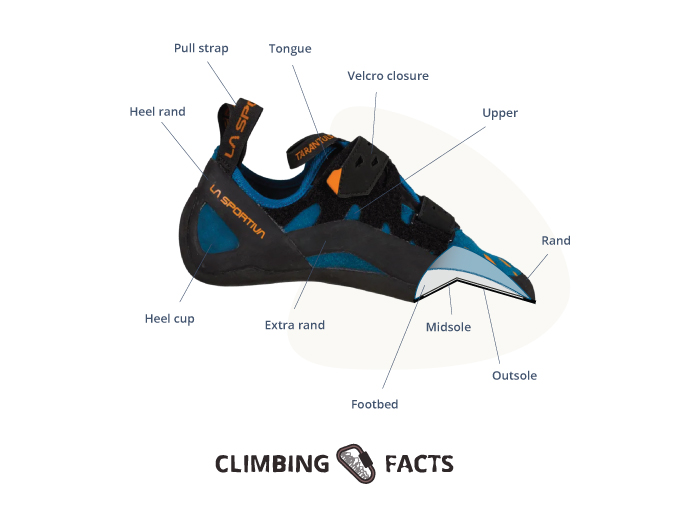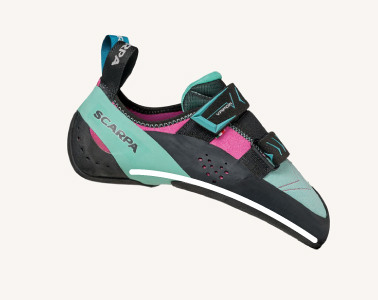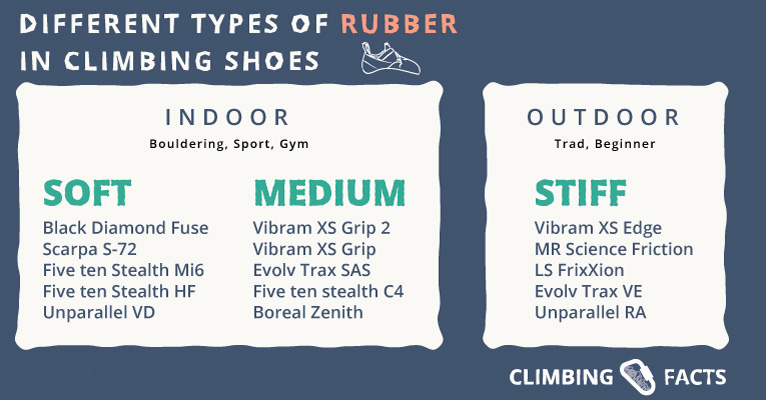Are you confused about which type of climbing shoe to get? Would your style of climbing benefit more from stiff or soft rubber? It gets very confusing, doesn’t it?
In this article, we’ll compare soft vs stiff rubber in climbing shoes. We’ll look at the difference between soft and stiff soles. We’ll also take a look at the common brands as well as clear up some misconceptions.
Once you’re done reading, you’ll have a good understanding of climbing rubbers and you’ll be ready to make the best choice for your style!
Stiff or soft, what does it mean?
When we refer to stiff or soft climbing shoes, we are referring to the soles that are used in them. A climbing shoe has two soles (a midsole and an outsole) which are contributing to the level of stiffness.
A stiff climbing shoe can be described as having a thick midsole and a thick layer of outside rubber (e.g. Vibram XS Edge). A soft climbing shoe, can be described as using a soft material for the rubber (e.g. Vibram XS Grip 2) and a thin, flexible midsole.
However, that’s not the only type of configuration.
Sometimes, climbing shoes have a soft and sticky outsole and a stiffer midsole. This makes them perform well at both smearing and edging, with the compromise that they don’t perform great at either.
Or you might run into a climbing shoe with a stiff rubber outsole and a flexible midsole.
To better understand how the soles inside a climbing shoe work, let’s take a look at the anatomy of a climbing shoe.

Read also: Anatomy of a climbing shoe
While everyone knows about the outsole, which is the visible part of rubber found at the bottom, you might not known about the midsole. The midsole is an invisible sole that sits between the outsole and the footbed.

Common Misconception:
The outsole of your climbing shoe is not the only contributing factor to the stiffness to the shoe. The midsole actually plays a bigger part in determining the stiffness (or softness) of your climbing shoe.
Sometimes climbing shoes with soft, sticky rubber come with a stiffer midsole to make them perform at both smearing and edging.
What are Stiff Climbing Shoes?
If you’ve worn a rental shoe before, you’re already familiar with stiff climbing shoes. They have a thick layer of rubber on the outside and don’t allow for a lot of sensitivity in the toe. The stiff rubber saves your toe muscles and ligaments as well as your lesg from strain, making them ideal for beginners.
But aside from beginners, stiff shoes also have a place in the outdoor climbing world. Just like beginners need the extra support, climbers who go on longer vertical routes (e.g. in trad climbing) also need a stiffer shoe to support them.
A stiff shoe will help you edge on the small footholds that are so commonly found on vertical rock faces. Simultanously, the stiffer sole will prevent your feet and legs from getting tired while you are climbing.
So to sum up, stiff climbing shoes are good at:
- Trad, multi-pitch climbing
- Edging on small footholds
- Sparing your feet and leg muscles
Example of a stiff climbing shoe: La Sportiva TC Pros.
What are Soft Climbing Shoes?
Soft climbing shoes have a thin, sticky layer of rubber at the bottom and a flexible midsole. In some cases, softer shoes don’t have any midsole at all. This thin layer of rubber makes smearing on big volumes a breeze at the cost of making edging on small footholds more difficult due to lack of support.
Soft climbing shoes are ideal for indoor gym climbing. Especially climbers who only (or predominantly) climb in the gym, want to go as soft as possible. This is because in climbing gyms smearing and standing on volumes is much more important than edging on small footholds.
Softer climbing shoes are also common in outdoor bouldering and sport climbing. These branches of climbing benefit greatly from the added sensitivity of soft rubber and the routes are short enough so that they don’t strain the muscles too much.
Soft climbing shoes are good at:
- Gym climbing, Bouldering, sport climbing
- Smearing on large volumes
- Hooking
Example of a soft climbing shoe: Scarpa Furia Air
Different types of climbing rubber
When climbers think about stiff or soft climbing shoes, they are most likely talking about the rubber that is used for the outsole of the shoe.
This rubber comes in three levels of stiffness: soft, medium-stiff, and stiff.
Below is a table of the most commonly used types of rubber in climbing shoes, ordered by their level of stiffness.
| Soft | Medium | Stiff |
|---|---|---|
| Black Diamond Fuse | Vibram XS Grip | Vibram XS Edge |
| Scarpa S-72 | Vibram XS Grip 2 | MR Science Friction |
| Five ten Stealth MI6 | Evolv Trax SAS | LS FriXxion |
| Five ten Stealth HF | Five ten Stealth C4 | Evolv Trax VE |
| Unparallel VD | Boreal Zenith | Unparallel RA |
Feel free to use our infographic below.

As you can see, soft and medium stiff rubbers are most ideal for indoor climbing, sport climbing and bouldering. Stiff rubbers are more commonly found in shoes designed for trad, multi-pitch, and big wall climbing as well as slabby and vertical terrain.
Some stiff rubbers (e.g. La Sportiva FrixXion Black) are designed specifically for beginner shoes.
Stiff vs Soft Climbing Shoes
As this article has been making clear, whether or not you need soft or stiff rubber, will depend on your style of climbing.
Here are some questions you should ask yourself:
- Are you climbing indoors or outdoor?
- What type of climber are you?
- What is your level of experience?
By asking these questions, you will get a better idea of what type of shoe will best fit your climbing style. Spoiler: most climbers require something in the middle.
Indoor or outdoor?
Many climbers climb both indoors and outdoor but if you would prioritize one, which would it be?
If you are primarily a gym climber who rarely or never goes outdoors, you should get a softer climbing shoe. A super stiff shoe simply does not belong in the gym. You don’t need that level of support, especially in modern climbing gyms with the huge volumes.
A stiff climbing shoe is designed for support and comfort. Two things you don’t have to worry about as an indoor climber where the routes/problems are short and you can easily take your shoes off in between sends.
Instead, you want to go for a soft climbing shoe with sticky rubber that will perform at smearing, volumes, and overhangs.
A good example is the Scarpa Drago
If however, you are an outdoor climber, who uses indoor facilities primarily to practice for the outdoors, then you’ll want a climbing shoe on the stiffer end of the spectrum.
But the level of stiffness you require will depend on what type of outdoor climbing you do as well as what kind of rock you are climbing.
What type of climber are you?
Climbing shoes are designed with different types of climbing in mind: bouldering, sport climbing, trad climbing, and gym climbing.
You won’t use the same shoe for trad climbing (which is going to be very stiff) as you would for indoor bouldering (which is going to be very soft). Or at least, you shouldn’t.
So let’s look at the individual climbing disclipines…
For bouldering, you will want to have a climbing shoe with soft rubber if your focus is only indoor bouldering as you will be smearing on big volumes. If you favor outdoor bouldering, you will want to go for a shoe with a soft sticky rubber sole and a stiffer midsole. The sticky, soft outsole will help the shoe perform on big volumes in indoor gyms and the stiffer midsole will help support you when edging on small footholds outdoor.
A great example is the La Sportiva Solution which is a medium-stiff shoe that is excellent for outdoor bouldering as well as sport climbing. If you are more of an indoor boulderer, the La Sportiva Solution Comp is a softer version of the Solution. If you want even softer shoes, you can look at a Scarpa Drago or Scarpa Furia Air.
Just like outdoor bouldering, for sport climbing you want to stay within the medium-stiff range. Medium-stiff climbing shoes with sticky rubber will be your best bet. The stiffness will allow you to edge on small rock footholds and the soft sticky rubber will help you with hooking on steep overhangs.
Sport climbing and bouldering have a bit of an overlap in this aspect. Once again we recommend the La Sportiva Solution as well as the La Sportiva Miura and the Scarpa Instinct VS.
If your discipline is trad climbing, you will want to go for a stiffer shoe that holds up well on small footholds and supports your feet on long routes.
A good example is the La Sportiva TC Pros.
What is your level of experience?
How long you have been climbing is an important factor in choosing the rubber for your climbing shoes. Climbing shoes designated for beginners have stiff soles for exactly this reason. As a beginner, you will benefit greatly from a stiffer shoe, even if you will primarily climb indoors.
A stiffer shoe will not only offer better support and make up for your newbie footwork, but it will also reduce the strain on your feet and leg muscles. This is something you don’t want to overlook. New climbers’ bodies already have enough new muscle groups and tendon strain to deal with, you don’t want to add any more to that list.
If your climbing style will benefit from softer climbing shoes (e.g. indoor bouldering), you should gradually make your way there and don’t force it. Even if you have been climbing for a couple of months, you are better of with a medium-stiff intermediate shoe than a super soft performance shoe.
Soft or Stiff Climbing Shoes – Which is the best for your climbing?
Get a stiffer shoe if:
- Trad, multi-pitch, big wall climbing
- You are a beginner getting their first shoe
- You climb a lot of cracks, slabby and vertical terrain
- You do a lot of edging
- You climb long routes
Get a softer shoe if:
- Sport climbing, Bouldering
- You climb primarily indoors
- You want more sensitivity in your toes
- You climb a lot of overhung terrain and big volumes
- You do a lot of smearing
- You climb short routes/problems
TIP: Go medium–stiff for the best all-around shoe
The majority of our readers are boulderers and sport climbers. If you fall within that audience, your best bet is to get a medium-stiff climbing shoe that will be an all-around monster.
Here’s what a medium-stiff climbing shoe looks like:
- Soft, sticky rubber sole: allows it to easily stick to flat surfaces (e.g. big indoor volumes)
- Stiffer midsole: allows it to edge better on small footholds outdoors
Continue Reading
More articles like this
- Indoor Bouldering Basics: intro to gym climbing
- Tips for short climbers
- Complete Guide to Bouldering Grades (& conversions)
- How to start and finish a boulder problem
- Can I get abs from climbing?
- Bouldering vs rock climbing
- How often you should go bouldering per week
- Why bouldering is a good full-body workout
- Climbing 101: what is cutting feet?
- How long does it take to progress in bouldering?
- How much does it cost to start bouldering?
- What to wear indoor bouldering
- How much of a bouldering wall can you use?
- Should climbing shoes hurt?
- How many climbing shoes do you really need?
- Yoga for climbers
- Core workout for climbers

